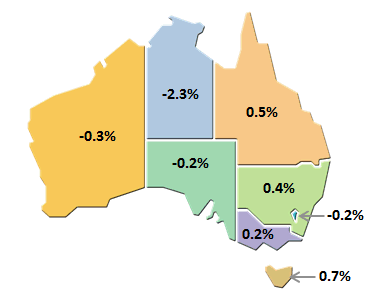MAIN FEATURES STATE FINAL DEMAND CHAIN VOLUME MEASURES
 |  | Seasonally adjusted, % change from Dec 18 to Mar 19 |
 |  | NSW | Vic. | Qld | SA | WA | Tas. | NT | ACT | Aust.(a) |
 |  |  |  |  |  |  |  |  |  |  |
|
| Final consumption expenditure |  |  |  |  |  |  |  |  |  |
 | General government | 0.6 | 2.4 | -0.5 | 0.5 | 1.5 | 1.5 | -0.4 | -0.3 | 0.8 |
 | Households | 0.4 | 0.3 | 0.2 | - | 0.1 | -0.3 | 0.1 | 0.3 | 0.3 |
| Gross fixed capital formation |  |  |  |  |  |  |  |  |  |
 | Private | -0.8 | -1.5 | 0.7 | 3.0 | -2.2 | 2.3 | -12.4 | 2.2 | -1.0 |
 | Public | 3.2 | -2.3 | 7.5 | -16.2 | -3.5 | 3.3 | -1.8 | -6.5 | 0.4 |
| State final demand | 0.4 | 0.2 | 0.5 | -0.2 | -0.3 | 0.7 | -2.3 | -0.2 | 0.1 |
|
| - nil or rounded to zero (including null cells) |
| (a) Australia estimates relate to Domestic final demand. |
MARCH QUARTER
Summary Comments
Australia
- Australia's domestic final demand increased 0.1%. Government final consumption expenditure was the largest contributor to growth driven by national non-defence. Household final consumption expenditure rose modestly. Private gross fixed capital formation detracted from growth, with falls in dwelling investment and ownership transfer costs.
State final demand, Quarterly Volume measures
: Seasonally adjusted
 New South Wales
New South Wales
- New South Wales' state final demand increased 0.4% following a 0.1% decrease in the December quarter. Consumption of household and national government expenditure drove the rise. Public investment strengthened to 3.2% driven by state and local general government. This was partly offset by private investment with dwelling investment accounting for the majority of the fall.
Victoria
- Victoria's state final demand increased 0.2% following a 0.9% increase in the December quarter. Government and household final consumption expenditure contributed to growth. Private investment partly offset these rises, driven by falls in dwelling investment and ownership transfer costs. The decrease in private investment was tempered by rises in non-dwelling construction and purchases of machinery and equipment. Public investment decreased mainly due to the general government sector.
Queensland
- Queensland's state final demand increased 0.5% with strong growth in public gross fixed capital formation driven by a large increase in investment by the state and local general government. Private investment growth was driven by dwelling construction but tempered by a fall in non-dwelling construction. Household consumption expenditure rose but was offset by a fall in government consumption.
South Australia
- South Australia's state final demand decreased 0.2% following a 0.9% increase in the December quarter. The fall was driven by public investment with the state and local general government contracting following large purchases of new assets in the December quarter. Private investment partly offset the fall in public investment, with non-dwelling construction increasing strongly. Government final consumption expenditure increased with state and local general government increasing spending. Household final consumption expenditure was flat for the quarter.
Western Australia
- Western Australia's state final demand continued to decrease, recording a decline of 0.3%. Private investment drove the decline with falls in machinery and equipment and dwelling investment. Non-dwelling construction rose, following five quarters of detraction. Public investment contributed to the decline with state and local public corporations the major contributor. Government consumption rose while household consumption was flat.
Tasmania
- Tasmania's state final demand increased 0.7%. State and local public spending contributed strongly to growth. Private investment increased, driven by machinery and equipment, tempered by declines in dwelling investment.
Northern Territory
- Northern Territory's state final demand decreased 2.3%, the sixth consecutive fall. Private investment continued to detract from growth, driven by non-dwelling construction. Household final consumption expenditure rose 0.1% following two consecutive falls. Public investment fell 1.8%, driven by state and local public corporations, this was partly offset by an increase from the general government.
Australian Capital Territory
- Australian Capital Territory's state final demand decreased 0.2%. General government spending was the main driver of the fall. This was partly offset by private investment in non-dwelling construction and machinery and equipment. Household final consumption expenditure rose 0.3%.
 Quality Declaration
Quality Declaration  Print Page
Print Page
 Print All
Print All